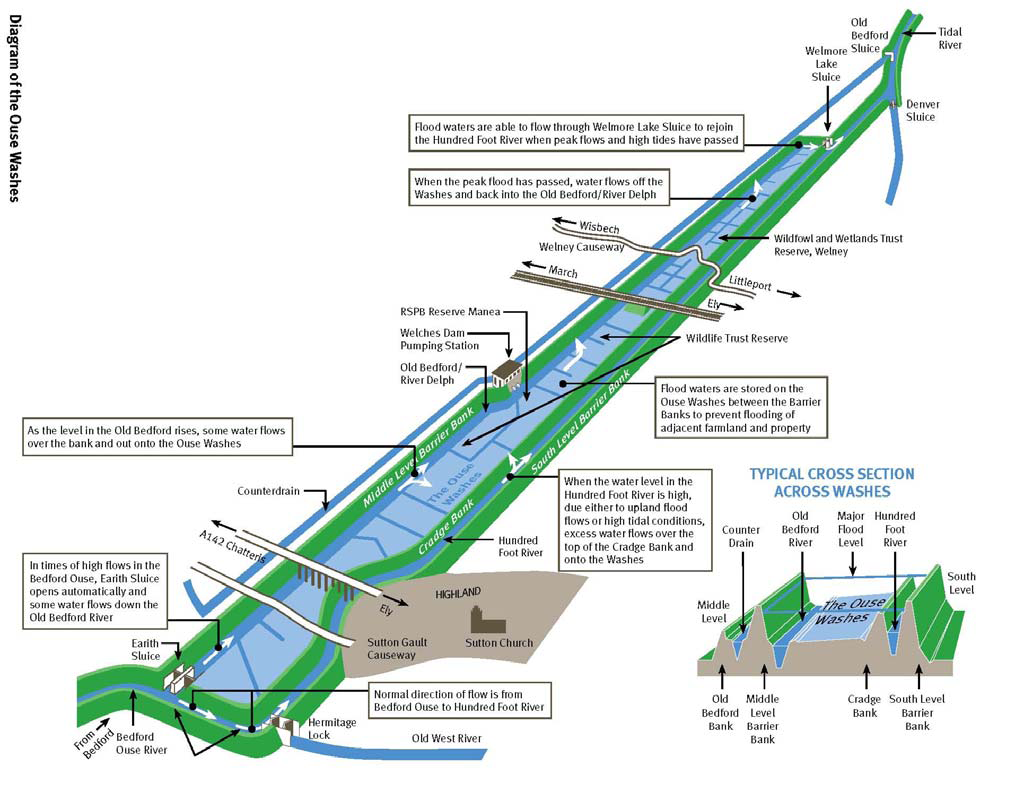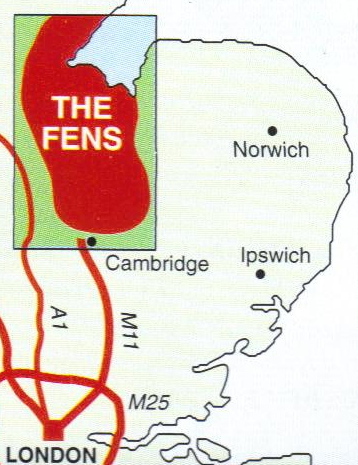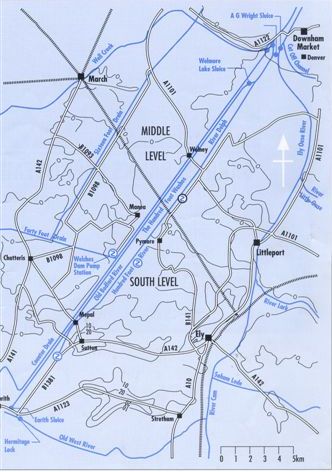Home page
Introduction
"Ouse Washes" is a relatively modern term used (since the 1970s ?) to refer to the floodplain known for more than three and a half centuries as the "Hundred Foot Washes" - a small, but very important, part of the flat low-lying peat 'fen' lands in 'East Anglia' (the eastern part of England).The area, locally simply called "The Washes", is a long, narrow strip of land through which the waters of the River Great Ouse (RGO) (NOT Great Ouse River as commonly called) flow in various man-made channels en-route to the sea. The strip is 21 miles long overall, but only 19 miles is (now) subject to flooding.

Plan by Environment Agency in public domain
Note that there are floodplains elsewhere in East Anglia also locally called The Washes e.g. the Nene Washes, and also in other parts of England.
There is much to cause confusion if not properly defined. This website aims to do that.
Definition
A "wash" is simply a piece of pasture land that is flooded every winter either naturally or intentionally, and grazed in summer.In the Ouse/Hundred Foot Washes the land is divided into individual fields each surrounded by ditches which are kept filled with water when the field is grazed to act as 'wet fences' (stock barriers) and for the cattle or sheep to drink from. In dry conditions water may have to be let in, or pumped in, from nearby rivers. The land wasn't so divided originally - see 'Shrinkage' section below.
A number of adjacent wash fields are collectively "washes". There are about 300 fields in the Ouse Washes (later note: more than 400 fields identified by the late Mike Dellanoy of Mepal) and approx 140 km of ditches.
The aerial view below shows the

This website is about these washes and the surrounding rivers and adjacent roads and structures which have helped create the washes, or have been built because of them.
Location

above, The Fens

The various Bedford Rivers refered to in the text, plus the old course of the River Great Ouse via the Old West, Cam, and Ely Ouse Rivers.
They occupy a ½-¾ mile (0.8-1.2km) wide strip of land set at an angle of approx 45 degrees on the map, starting at Earith, which was in Huntingdonshire but since the 1970s(?), in Cambridgeshire, running north-east into Norfolk, originally finishing some 21 miles (33.8km) away at Salter's Lode, but now ending 1½-2 miles (2.4-3.2km) south of there at the John Martin sluice at Welmore Lake. More of all that later.
They are bounded throughout their length by two parallel rivers; on the west by the non-tidal Old Bedford/Delph; and on the east by the tidal New Bedford (also known as the Hundred Foot River or Drain).
In the south, the boundary is a very short section of what is known as the Bedford Ouse (which is actually the River Great Ouse) and in the north it is a short stretch of what is locally and perhaps confusingly called 'The Tidal River', which is also the River Great Ouse.
The map shows the washes and its rivers run a shade north of north-east and many refer to the sides as "north" and "south" (as Vermuyden did) but others say "west" and "east". Just about everything to do with the Ouse Washes, which of course is really the Hundred Foot Washes, is confusing.
Boundaries
This is another area of confusion. There are three versions.- As detailed above, Vermuyden's boundaries were the west bank of the OBR (the Middle Level Barrier Bank, MLBB) and the east bank of 100 Ft/NBR (the South Level Barrier Bank, SLBB).
In 1771 the Delph River was cut across the Washes in the north to Welmore Lake, removing a small area of the Washes from the flood reservoir. - The SSSI, Site of Special Scientific Interest, created in 1955 under the 1949 Act includes the above PLUS the Counter Drain/Old Bedford River. In 1971 the area of arable land outside the flood plain in the north was excluded
- The RAMSAR site and SPA, Special Protection Area, have the same boundaries as the SSSI.
- In 1975 under the Reservoir Act, Vermuyden's eastern boundary was changed. The 100Ft/NBR and SLBB were removed, and the new boundary was the Cradge Bank
- The souther boundary is commom to all, the Bedford Ouse
Role
First and foremost, the Ouse or Hundred Foot Washes provide a (mainly) winter floodwater storage area of nearly 6,000 acres protecting surrounding lands from inundation. That was, and still is, its primary function created by Vermuyden in 1652.- Heavy upstream fluvial water from the Bedford Ouse (a stretch of the RGO) can enter the Old Bedford River at Earith Sluice in the south-west and then gradually over-flow its low east bank into the Washes
- Heavy incoming tides in the Hundred Foot/New Bedford River (which is also the RGO) could overflow its low west bank into the Washes in the north-east. Later that bank was raised creating the "Cradge Bank" to keep saline water away from the cattle pastures. I witnessed that bank being overtopped in 2012/3 near Mepal; I think it has since been raised.
In Summer, water levels are reduced first by gravity then by pumping at Welmore Lake Sluice to provide grazing for cattle and sheep within the washes and irrigation for arable lands outside.
Nature conservation is another major use, with a nature reserve and a wildfowl refuge. The Washes are recognised internationally as a "Site of Special Scientific Interest" (SSSI).
Much of the system is navigable, although sometimes with difficulty in places, and one link to another navigation system has been closed due to leakage and lack of maintenance. Usage is however almost exclusively recreational.
Where next?
There are over 50 pages on this site. Some give an overall summary with tabular data, others with fuller details and photos. The "overview" and "features" pages are recomended for next viewing, then the A-Z contents page for links to the more detailed pages. If you want to know why and how the site was started back in 2011, go to the "blog" page. Links are below.To open index press firmly and hold, then tap a subject; or hover mouse. You can return to the index anytime via button on left.
links
Museums listed will help you understand more about drainage, farming and rural life and help preserve our heritage.
External sites or pages will open in new windows or tabs and this site will remain open.
The "Fens, rivers & washes overview" on another of my websites, the Welney Website, gives a good concise summary and is worth a visit, but please come back!



Page created May 2011, last edited: 08/12/25, 22:12